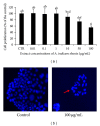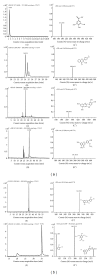In Vitro Antiproliferative Effect of Arthrocnemum indicum Extracts on Caco-2 Cancer Cells through Cell Cycle Control and Related Phenol LC-TOF-MS Identification
- PMID: 24348703
- PMCID: PMC3856152
- DOI: 10.1155/2013/529375
In Vitro Antiproliferative Effect of Arthrocnemum indicum Extracts on Caco-2 Cancer Cells through Cell Cycle Control and Related Phenol LC-TOF-MS Identification
Abstract
This study aimed to determinate phenolic contents and antioxidant activities of the halophyte Arthrocnemum indicum shoot extracts. Moreover, the anticancer effect of this plant on human colon cancer cells and the likely underlying mechanisms were also investigated, and the major phenols were identified by LC-ESI-TOF-MS. Results showed that shoot extracts had an antiproliferative effect of about 55% as compared to the control and were characterised by substantial total polyphenol content (19 mg GAE/g DW) and high antioxidant activity (IC50 = 40 μ g/mL for DPPH test). DAPI staining revealed that these extracts decrease DNA synthesis and reduce the proliferation of Caco-2 cells which were stopped at the G2/M phase. The changes in the cell-cycle-associated proteins (cyclin B1, p38, Erk1/2, Chk1, and Chk2) correlate with the changes in cell cycle distribution. Eight phenolic compounds were also identified. In conclusion, A. indicum showed interesting antioxidant capacities associated with a significant antiproliferative effect explained by a cell cycle blocking at the G2/M phase. Taken together, these data suggest that A. indicum could be a promising candidate species as a source of anticancer molecules.
Figures




Similar articles
-
Anticancer effect of Tamarix gallica extracts on human colon cancer cells involves Erk1/2 and p38 action on G2/M cell cycle arrest.Cytotechnology. 2013 Dec;65(6):927-36. doi: 10.1007/s10616-013-9564-4. Epub 2013 Jun 26. Cytotechnology. 2013. PMID: 23801270 Free PMC article.
-
HPLC-MS Profiling, Antioxidant, Antimicrobial, Antidiabetic, and Cytotoxicity Activities of Arthrocnemum indicum (Willd.) Moq. Extracts.Plants (Basel). 2022 Jan 17;11(2):232. doi: 10.3390/plants11020232. Plants (Basel). 2022. PMID: 35050120 Free PMC article.
-
Phytochemical screening and antioxidant, antimitotic, and antiproliferative activities of Trichodesma indicum shoot.Anc Sci Life. 2014 Oct-Dec;34(2):113-8. doi: 10.4103/0257-7941.153480. Anc Sci Life. 2014. PMID: 25861148 Free PMC article.
-
Human cancer cell antiproliferative and antioxidant activities of Juglans regia L.Food Chem Toxicol. 2010 Jan;48(1):441-7. doi: 10.1016/j.fct.2009.10.043. Epub 2009 Oct 31. Food Chem Toxicol. 2010. PMID: 19883717
-
Qualitative and quantitative analysis of phenolics in Tetrastigma hemsleyanum and their antioxidant and antiproliferative activities.J Agric Food Chem. 2013 Nov 6;61(44):10507-15. doi: 10.1021/jf4037547. Epub 2013 Oct 23. J Agric Food Chem. 2013. PMID: 24151872
Cited by
-
Salt-Tolerant Plants, Halophytes, as Renewable Natural Resources for Cancer Prevention and Treatment: Roles of Phenolics and Flavonoids in Immunomodulation and Suppression of Oxidative Stress towards Cancer Management.Int J Mol Sci. 2023 Mar 8;24(6):5171. doi: 10.3390/ijms24065171. Int J Mol Sci. 2023. PMID: 36982245 Free PMC article. Review.
-
A metabolomics approach to evaluate the effect of lyophilization versus oven drying on the chemical composition of plant extracts.Sci Rep. 2021 Nov 22;11(1):22679. doi: 10.1038/s41598-021-02158-6. Sci Rep. 2021. PMID: 34811431 Free PMC article.
-
Anti-Proliferative Effects of Methanol and Water Extracts of Pyrrosia piloselloides on the Hela Human Cervical Carcinoma Cell Line.Asian Pac J Cancer Prev. 2019 Jan 25;20(1):185-192. doi: 10.31557/APJCP.2019.20.1.185. Asian Pac J Cancer Prev. 2019. PMID: 30678430 Free PMC article.
-
Effects of Isorhamnetin on Diabetes and Its Associated Complications: A Review of In Vitro and In Vivo Studies and a Post Hoc Transcriptome Analysis of Involved Molecular Pathways.Int J Mol Sci. 2022 Jan 9;23(2):704. doi: 10.3390/ijms23020704. Int J Mol Sci. 2022. PMID: 35054888 Free PMC article. Review.
-
Halophyte Plants as Potential Sources of Anticancer Agents: A Comprehensive Review.Pharmaceutics. 2022 Nov 8;14(11):2406. doi: 10.3390/pharmaceutics14112406. Pharmaceutics. 2022. PMID: 36365224 Free PMC article. Review.
References
-
- Gülcin I, Uguz MT, Oktay M, Beydemir S, Küfrevioglu OI. Evaluation of the antioxidant and antimicrobial activities of Clary Sage (Salvia sclarea L.) Turkish Journal of Agriculture and Forestry. 2004;28:25–33.
-
- Gackowski D, Banaszkiewicz Z, Rozalski R, Jawien A, Olinski R. Persistent oxidative stress in colorectal carcinoma patients. International Journal of Cancer. 2002;101(4):395–397. - PubMed
-
- Lo C, Lai T-Y, Yang J-H, et al. Gallic acid induces apoptosis in A375.S2 human melanoma cells through caspase-dependent and -independent pathways. International Journal of Oncology. 2010;37(2):377–385. - PubMed
-
- Yang Y-P, Liang Z-Q, Gao B, Jia Y-L, Qin Z-H. Dynamic effects of autophagy on arsenic trioxide-induced death of human leukemia cell line HL60 cells. Acta Pharmacologica Sinica. 2008;29(1):123–134. - PubMed
LinkOut - more resources
Full Text Sources
Other Literature Sources
Research Materials
Miscellaneous

